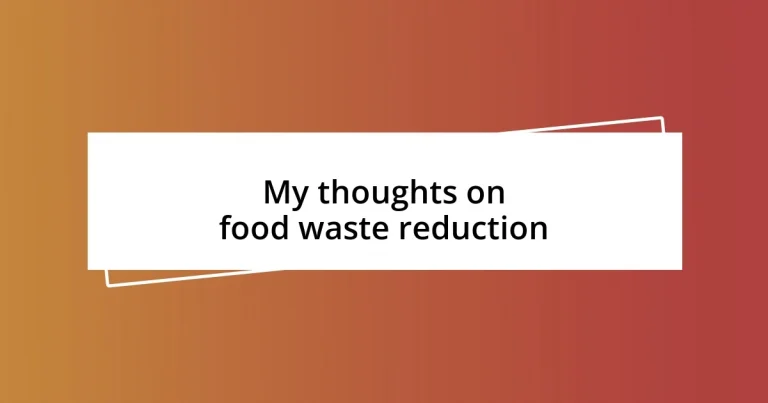Key takeaways:
- Nearly one-third of food produced for consumption is wasted annually, highlighting the disconnect between food availability and global hunger.
- Effective strategies to reduce food waste include meal planning, repurposing leftovers, and proper food storage techniques.
- Community initiatives, such as food-sharing programs and composting, can significantly impact food waste reduction and promote sustainability.

Understanding food waste issues
Food waste is a staggering issue that often goes unnoticed in our daily lives. I remember cleaning out my fridge one day and finding a perfectly good head of lettuce that had turned limp and brown, making me question why I hadn’t used it sooner. It struck me then how often we take good food for granted, tossing it aside while many around the world go hungry.
Every year, a significant portion of the food produced for human consumption is wasted—nearly one-third, according to estimates. Imagine the resources involved in growing, transporting, and packaging that food, all for it to end up in the trash. How does this reality sit with you when you think about sustainability and our planet?
Understanding food waste issues isn’t just about the numbers; it’s also about the stories behind the food. I vividly recall volunteering at a local food bank, where we sorted through donations, sometimes noticing perfectly good items that were deemed “unsellable.” This experience highlighted not just waste, but also the disconnect between availability and need. What if we could bridge that gap?

Reasons for food waste today
One of the primary reasons for food waste today is the sheer volume of food being overproduced. In my experience working in restaurants, I’ve seen kitchens prepare far more food than needed for a single evening, leading to mountains of leftovers that often end up in the trash. This mentality of abundance, coupled with our consumer culture that prioritizes quantity over quality, has resulted in a shocking amount of waste.
- Consumer Behavior: Many people purchase more food than they need, often influenced by sales promotions or fear of running out.
- Misunderstood Expiration Dates: Confusion around “sell by” and “use by” dates leads to perfectly edible food being discarded prematurely.
- Aesthetic Standards: Fruits and vegetables that do not meet the “perfect” appearance often get discarded by both retailers and consumers.
- Lack of Awareness: There is a general lack of understanding of the impact of food waste, not just on the environment but on global hunger.
It’s also worth noting that our systems for distribution often prioritize aesthetics over taste, which was a surprise to me when I worked alongside farmers and learned about their struggles to sell produce that didn’t conform to warehouse standards. The disconnect between food appearance and its edibility can be heartbreaking. I still remember a farmer showing me freshly harvested tomatoes that, despite their less-than-perfect shape, tasted incredible. Their fate? Often relegated to compost piles instead of being enjoyed at the dinner table.

Strategies for reducing food waste
Reducing food waste isn’t just a noble goal; it’s entirely achievable with practical strategies. One effective approach I’ve found is meal planning. By planning my meals for the week, I can buy only what I need, ensuring the ingredients I purchase are used up. Reflecting on how much my weekly grocery bill has decreased since I started this practice, I can confidently say it’s been a game changer for both my wallet and my kitchen.
Another strategy involves repurposing leftovers creatively. I once attended a potluck where everyone brought an extra dish made from their leftover ingredients. It was inspiring to see how much creativity emerged when creating meals from what would typically be waste. Not only did we reduce food waste collectively, but we also shared ideas for future meals, fostering a sense of community.
Lastly, educating ourselves on proper food storage can significantly reduce waste at home. For instance, I learned that storing my herbs upright in water keeps them fresher for longer. Understanding the best ways to keep produce vibrant and delicious has transformed my fridge from a place of forgotten items into a vibrant showcase of fresh, usable ingredients.
| Strategy | Description |
|---|---|
| Meal Planning | Organizing weekly meals to buy only necessary ingredients, minimizing excess. |
| Repurposing Leftovers | Creating new meals from leftover ingredients to encourage creativity and community. |
| Proper Food Storage | Learning correct storage techniques to prolong freshness and edibility of food. |

How to plan meals effectively
When I started planning my meals for the week, I was surprised by how much simpler grocery shopping became. It was almost like unlocking a new level in a game; suddenly, I wasn’t wandering aimlessly through aisles, but rather sticking to a list. The satisfaction of seeing all my ingredients utilized by the end of the week made me wonder—why hadn’t I done this sooner?
One evening, after prepping for a week of meals, I found myself with a bunch of spinach nearing its end. Instead of letting it wilt away, I tossed it into a quick pasta dish. The burst of freshness it added surprised me, and it sparked a thought—how often do we overlook using ingredients simply because we didn’t plan for them? Keeping an open mind about creativity in meal prep can lead to delightful discoveries.
Lastly, I remember a time when I left my herbs in their plastic packaging, only for them to spoil within days. Once I learned to store them in jars of water, their vibrancy returned, transforming my kitchen. It struck me how a small shift in storage could drastically change the lifespan of fresh ingredients. Isn’t it empowering to know that with just a little change in mindset, we can all extend the life of our food and reduce waste?

Tips for using leftovers creatively
One of my favorite ways to use leftovers creatively is to transform them into breakfast. I often find myself with extra roasted vegetables and grains after dinner. Scrambling some eggs and mixing in those veggies not only makes for a hearty morning meal but also brightens up my day. Have you ever tried turning your previous night’s dinner into a brunch recipe? It’s a delicious surprise that can kick-start your morning with minimal effort.
Another tip I swear by is making homemade soups or stews. I remember a chilly day when I found a mix of leftover meats and veggies in my fridge, each one patiently waiting for their moment. I decided to toss them all into a pot with some broth, and what emerged was a comforting, hearty soup that warmed me from the inside out. It’s fascinating how what once seemed like random leftovers can come together to create something so nourishing. Have you thought about how versatile a good broth can be?
I also love experimenting with leftover bread. There are days when I end up with half a loaf that’s just begging to be used. One time, I whipped up a simple bread pudding with some milk, eggs, and a handful of raisins I had left in the pantry. That sweet, indulgent dessert reminded me just how delightful a twist on forgotten ingredients can be. Why not think outside the box with your next batch of leftovers?

Community initiatives for waste reduction
Community initiatives play a vital role in tackling food waste, and I’ve witnessed some incredible local projects firsthand. For instance, I participated in a community food-sharing program where homes with excess produce could donate their fruits and veggies. Seeing a neighbor’s tomatoes transformed into a delightful salsa for a local food pantry was heartwarming. Have you ever thought about how simple acts of sharing can create such a ripple effect in a community?
Another impressive initiative I came across was a community composting program. I initially approached composting with hesitation, feeling it was a chore. However, joining a local composting group has changed my perspective. I remember how excited I felt when I learned to turn kitchen scraps into nutrient-rich soil, which ultimately nourished our community garden. Isn’t it wonderful how something as mundane as waste can give back to the earth in such an impactful way?
Lastly, I’ve seen schools engage in waste reduction through educational workshops focused on sustainable practices. One memorable session involved kids transforming leftovers into healthy snacks while learning about nutrition. Their enthusiasm was contagious, and it made me reflect on the long-term benefits of instilling such values in the younger generation. Have you ever considered how the seeds we plant today can grow into a more sustainable future?














